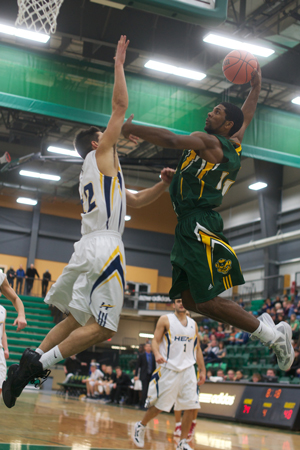
All Golden Bears and Pandas Athletics teams will use the new High Performance Training and Research Centre for training; researchers who work with elite level athletes will also be able to conduct research studies here.
When exercise physiologist Gordon Bell does his next study with elite level athletes, he'll have a new space in which to put them through their paces. The 9000 ft. 2 High Performance Training and Research Centre (HPTRC), located in the Saville Community Sports Centre, is the newest addition to the Faculty's research, teaching and training facilities.
Opened in September this year, the HPTRC is specifically earmarked for elite athlete training as well as sport science research. It may be just the thing for sport science researchers like Bell, long known for his research with Edmonton's rowers, cyclists, amateur and professional hockey players.
"From a sport science research perspective, the HPTRC would be useful to do assessments of high performance athletes involved in a research study," says Bell. "It will certainly be useful for doing strength and agility testing with athletes, as well as physiological testing using other types of exercise equipment not just strength equipment."
The Centre was originally conceived out of a need to provide a large, dedicated space for the University's varsity athletes to train and a place to offer academic courses. "What we've done is consolidated two training areas," says Pierre Baudin, who developed the HPTRC idea. "We've combined the equipment from the old weight room in the 'dungeon' in the East Wing of the Van Vliet Centre, and the Foote Field training centre and brought them to this new, large space at South Campus so our athletes have a dedicated place to come to for training."
For Bell, the new space is an important improvement and more appropriate to the type of training space varsity athletes need. "Previous to this the facilities we had were not very effective," says Bell. "The varsity weight room was too small and there wasn't alot of equipment. You could not train a whole team at once in there. Foote Field was a little bit bigger, but without the floor space to do agility training, short sprints, and non-equipment-based performance testing."
Two academic courses, PAC 490 - Strength Training, Strength and Power Training, and PAC 491 - Applied Endurance Training, also needed a new home when the space in the Van Vliet Centre's East Wing had to be given up for the construction of the new Physical Activity and Wellness Centre. They'll be taught here as well. It'll be a fitting space because it is set up for high-performance training, rather than like a typical gym, says Baudin. "We have 12 Olympic standard platforms which we built under the direction of biomechanics professor Loren Chiu, a former national champion weightlifter. The centre also has 16 spin bikes and all of the weights from the two training areas in the Van Vliet Centre and Foote Field that we vacated."
Bell says he's pleased the HPTRC has been developed and hopes the centre will soon have the equipment needed to provide a complete training experience for high performance athletes. "To cover all aspects of high-performance training in many varsity sports, it can't just be weights," he says. "We will need floor space with good quality flooring for agility and plyometrics and for exercises that aren't weight-lifting. Weights are only one part of what a high-performance athlete has to do. Players have to do aerobic training, sprint-training, plyometric-training, they need boxes, they need some open space; they need lots of other equipment to get the full effect."
The HPTRC will serve all of the University's Golden Bears and Pandas teams, junior level high performance athletes through the Alberta Sport Development Centre, high performance athletes with impairment through The Steadward Centre, and other provincial and national athletes.
Ian Reade, director of Golden Bears and Pandas Athletics says there are advantages to having junior up- and-comers train with varsity level athletes. "When aspiring athletes train around varsity athletes, they get a better sense of what level they train at and the kind of commitment they make. I think that will make a big difference."
For varsity athletes, Reade says it's a real advantage for different teams to be able to train beside each other. "Now they can all train together. Football players can work out beside soccer players and they can see what each other's training regimens are like. There'll be a lot more teambuilding and camaraderie. Also, over time this will develop a better culture of fitness and conditioning among our athletes."
Other elite athletes in Edmonton will be able to use the centre as affiliate members, but there is an application process vetted by a committee, led by Reade, who is also the director of the HPTRC. "We are certainly open to including clubs that have a high-performance mandate, with the appropriate level of coaching. Canadian Sport Centre athletes, who are funded by Sport Canada, will be able to work out at the HPTRC, for example."
While athletes will find a well-equipped training centre, both Reade and Baudin say providing a venue for research will be key for the new centre. "It is a priority of the facility," emphasizes Reade, adding that researchers looking to use the space can schedule their requirements through the centre's manager, Michael Cook, who also manages the Alberta Sport Development Centre - Capital Region.
According to Baudin, plans are already afoot to expand the centre to ensure that it can provide everything needed for rigorous high performance athlete training programs and the sport science research that underpins them.
The centre, which runs on a cost-recovery basis, is expected to serve 2500-3000 athletes per year, according to Reade.
For further information about using the HPTRC, including scheduling of research projects and user fees, contact Michael Cook at michael.cook@ualberta.ca, or phone 780-248-1982.